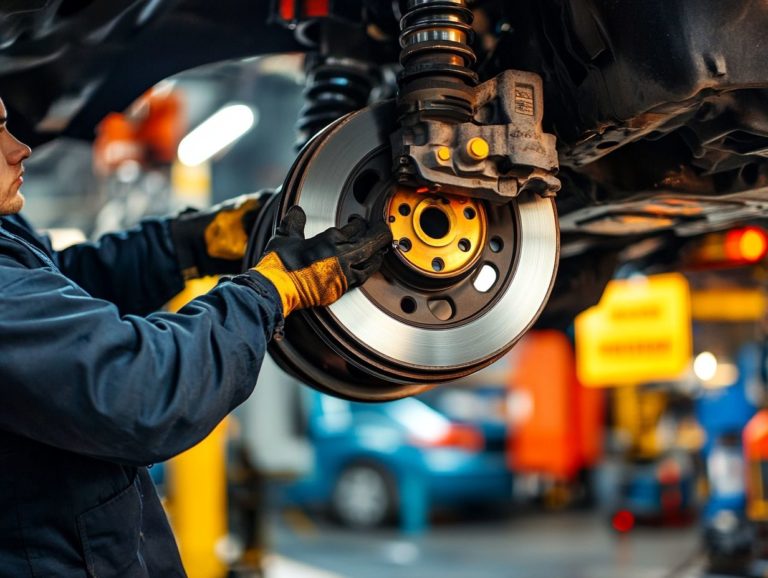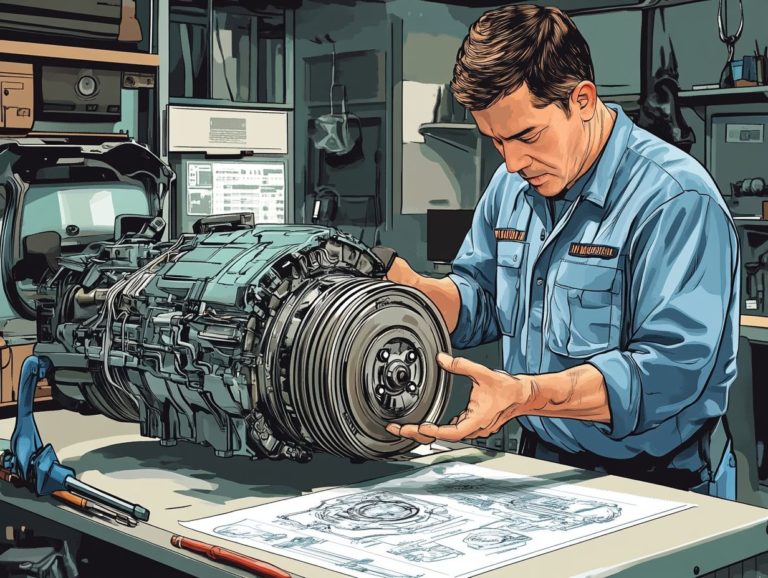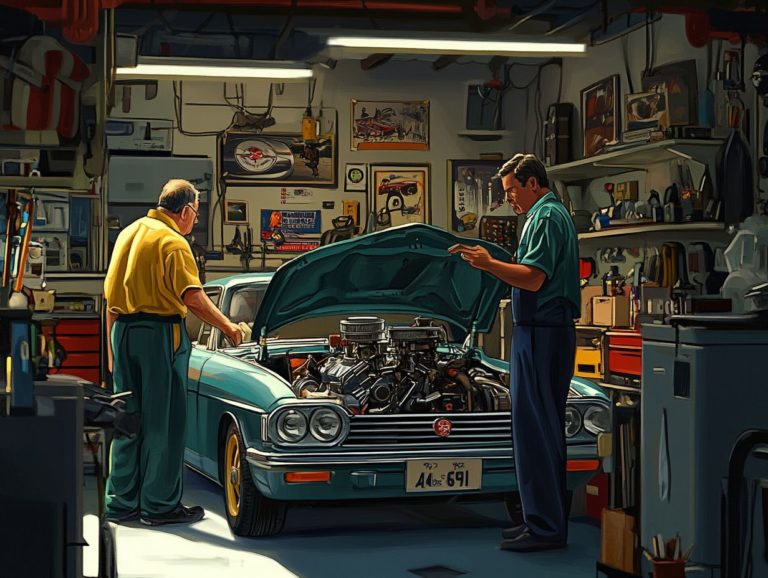Understanding Common Car Repair Terminology
Navigating the realm of car repairs can indeed feel overwhelming, especially with all the jargon swirling around. It’s essential for you, as a car owner, to grasp this terminology, whether you’re taking on DIY fixes or engaging in meaningful conversations with a mechanic.
This article demystifies common car terms and their meanings, guiding you through the process of diagnosing issues while offering step-by-step instructions for basic repairs. It also helps you find a trustworthy mechanic when you need one.
Get ready to take charge and feel confident behind the wheel!
Contents
- Key Takeaways:
- Common Terms and Definitions
- Diagnosing Car Problems
- Basic Car Repair Guide
- Finding Reliable Car Repair Services
- Frequently Asked Questions
- What is meant by ‘diagnostic code’ in understanding common car repair terminology?
- What is the difference between ‘preventive maintenance’ and ‘routine maintenance’ in understanding common car repair terminology?
- What does ‘OEM’ stand for in understanding common car repair terminology?
- What does ‘aftermarket’ mean in understanding common car repair terminology?
- What does ‘labour rate’ refer to in understanding common car repair terminology?
- What is meant by ‘warranty’ in understanding common car repair terminology?
Key Takeaways:
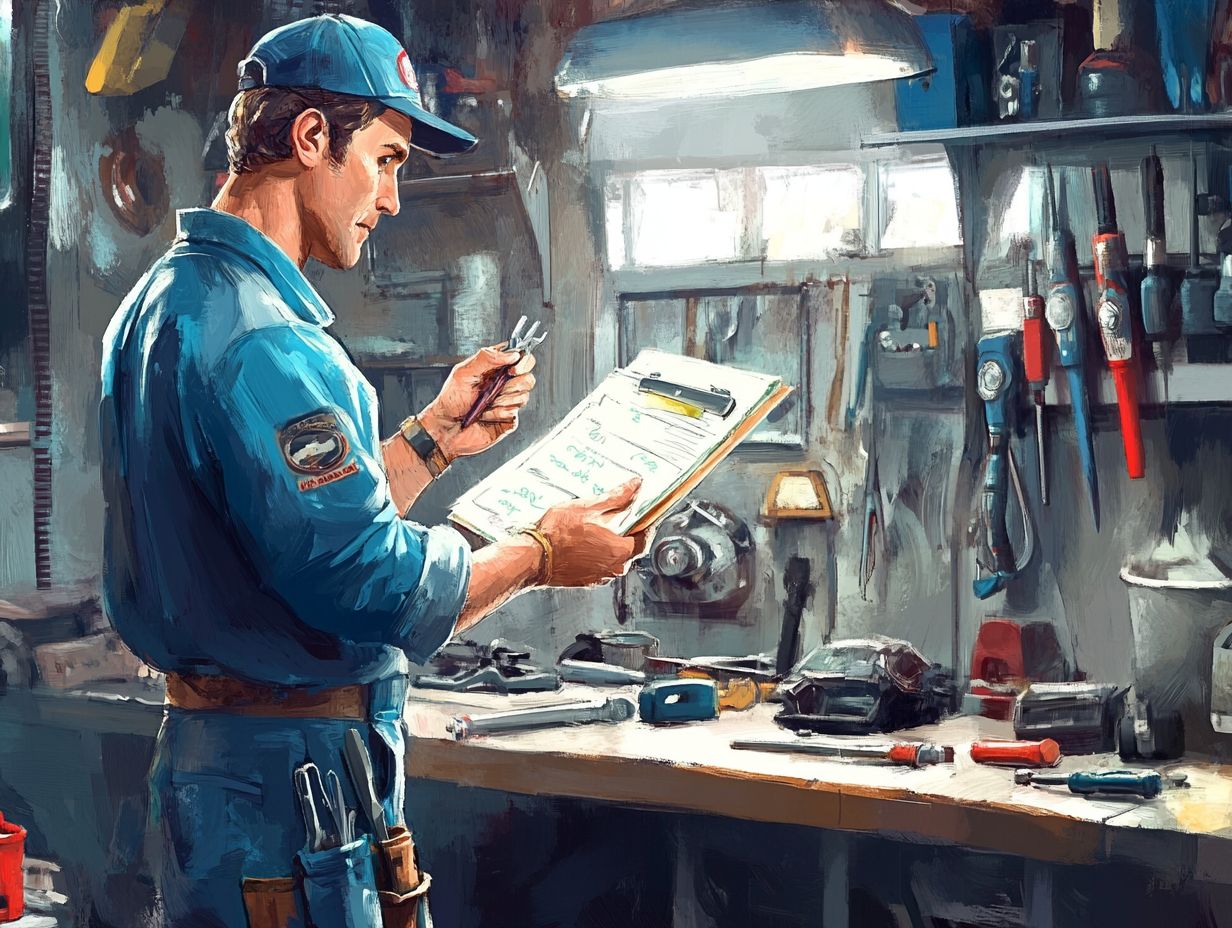
- Knowing common car repair terminology is crucial for effective communication with mechanics and understanding repair procedures.
- Familiarizing yourself with parts, tools, and techniques can make diagnosing car problems less intimidating.
- A basic understanding of car repairs can save money and provide a sense of empowerment when handling common issues.
Why Understanding Terminology is Important
Understanding vehicle terminology is essential for you to communicate effectively with your mechanic and make informed decisions about your car’s maintenance and repair needs, including common car repair warranties.
When you understand terms like brake fluid and engine oil, you gain a clearer insight into the importance of timely fluid checks and how they impact your vehicle’s safety and performance. For example, recognizing what an “ABS light” means a sign of an issue with your anti-lock braking system can prompt you to address potential braking issues before they escalate into more serious problems. This knowledge not only helps you diagnose issues but also enhances your conversations with automotive professionals.
By articulating your concerns with precision, such as indicating that the “engine oil” requires attention, you ensure that mechanics fully understand your needs. This clarity leads to more effective and efficient repairs, ultimately saving you time and money.
Common Terms and Definitions
Familiarity with common automotive terms is crucial for you as a car owner. It enables you to comprehend your vehicle’s maintenance needs and anticipate potential issues that may arise.
Understanding the language of automotive care not only enhances your confidence but also ensures you’re well-equipped to make informed decisions regarding your vehicle’s upkeep.
Parts and Components
Your car has important parts that work together. Understanding these components is essential for effective diagnostics and maintenance, allowing you to identify when something might be off.
Take brake pads, for instance. They are vital for slowing down or stopping your vehicle. When they wear out, you may start to hear squeaking noises or notice reduced stopping power. This can create hazardous situations on the road.
Similarly, the timing belt is responsible for synchronizing the engine s camshaft and crankshaft. If this belt snaps, you could face catastrophic engine damage, which is certainly not a pleasant surprise.
Then there’s the radiator, which is essential for regulating engine temperature. Any leaks or clogs can lead to overheating, potentially resulting in costly repairs.
By familiarizing yourself with these components, you not only enhance your vehicle’s performance but also extend its lifespan, ensuring that you stay safe and enjoy the drive.
Tools and Techniques
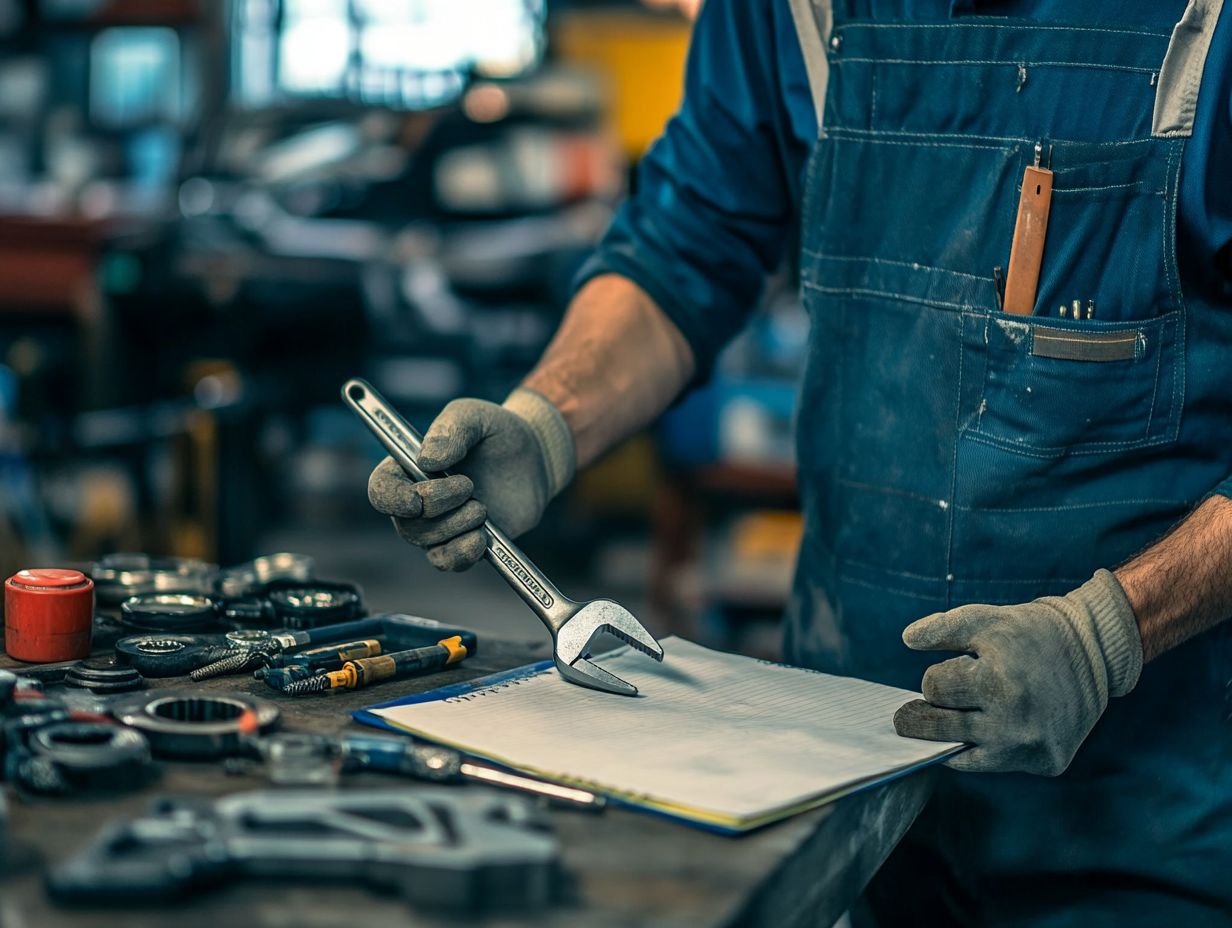
Utilizing the right tools and techniques is essential for automotive repair and maintenance. Whether you’re a car owner or a mechanic, effective diagnostics and maintenance depend on having the best resources at your fingertips.
Among the essential tools you’ll want to rely on are OBD-II scanners, which are devices that help read your car’s error codes. These devices are invaluable for identifying issues quickly and accurately. Understanding preventive maintenance techniques, such as regular oil changes and fluid checks, can significantly enhance your vehicle’s lifespan.
By conducting thorough inspections of critical components like brakes and tires, you can spot wear and tear before they develop into serious safety hazards. Understanding electrical voltage is crucial for ensuring all systems operate correctly, contributing to your vehicle s overall safety and reliability on the road.
Diagnosing Car Problems
Diagnosing car problems effectively requires keen observation and a solid grasp of various indicators. Pay close attention to diagnostic trouble codes, fluctuations in engine temperature, and warning lights, such as the ABS light.
These elements provide critical insights into your vehicle’s performance and guide you toward a precise understanding of any underlying issues. Now that you can diagnose issues, let’s explore how to identify and describe them effectively.
Identifying and Describing Issues
Identifying and accurately describing car issues can save you both time and money, leading to more efficient automotive repair and maintenance.
If you see low brake fluid levels, tell your mechanic immediately. Symptoms like a spongy brake pedal can indicate a serious issue, while a dashboard warning light may signal that your vehicle requires urgent attention.
Similarly, if you notice a drop in engine performance or hear unusual noises, it could be a dirty fuel filter, which can hinder fuel flow and compromise efficiency. Using precise terminology, like “brake fluid reservoir” or “fuel filter blockage”, facilitates clearer communication, allowing mechanics to diagnose and resolve issues more effectively. This ensures your vehicle remains safe and reliable on the road.
Basic Car Repair Guide
A comprehensive car repair guide enables you, the vehicle owner, to tackle essential maintenance tasks with confidence. With this knowledge, you can easily handle an oil change, replace spark plugs, or swap out brake pads, ensuring your vehicle runs smoothly.
Step-by-Step Instructions for Common Repairs

Following step-by-step instructions for common repairs can significantly elevate your understanding of car maintenance and simplify the entire process.
By gaining hands-on experience in essential tasks like performing oil changes, replacing brake pads, and maintaining the battery, you not only save money but also empower yourself to tackle automotive issues with confidence. Recognizing the importance of regular oil changes helps prevent engine wear, and knowing how to replace brake pads ensures your safety and optimal braking performance.
Proper battery maintenance, such as cleaning terminals and checking connections, can extend the life and reliability of your battery. With these skills, you can approach your vehicle with newfound confidence, equipped with the necessary terminology and safety tips to navigate your repairs successfully.
Finding Reliable Car Repair Services
Finding reliable car repair services is essential for preserving your vehicle’s performance and extending its lifespan. Understanding how to select a trustworthy mechanic can elevate your driving experience and provide you with peace of mind.
How to Choose a Trustworthy Mechanic
Choosing a trustworthy mechanic requires some effort on your part. Dive into their qualifications, check out customer reviews, and take note of their approach to automotive repair and maintenance.
Look for specific certifications that signal the mechanic has completed rigorous training. Knowing how long they ve been in the industry can help you gauge their experience level. A reliable mechanic will be transparent about their diagnostic process, offering clear explanations for any trouble codes they encounter during vehicle assessments.
Feel free to ask questions! It shows you re engaged and care about your vehicle. Inquire about their methods or past work. Asking about warranties on repairs or suggestions for preventative maintenance can reveal a great deal about their competence and trustworthiness. Ultimately, building a good rapport can significantly boost your confidence in their abilities and enhance the overall service you receive.
Frequently Asked Questions
What is meant by ‘diagnostic code’ in understanding common car repair terminology?
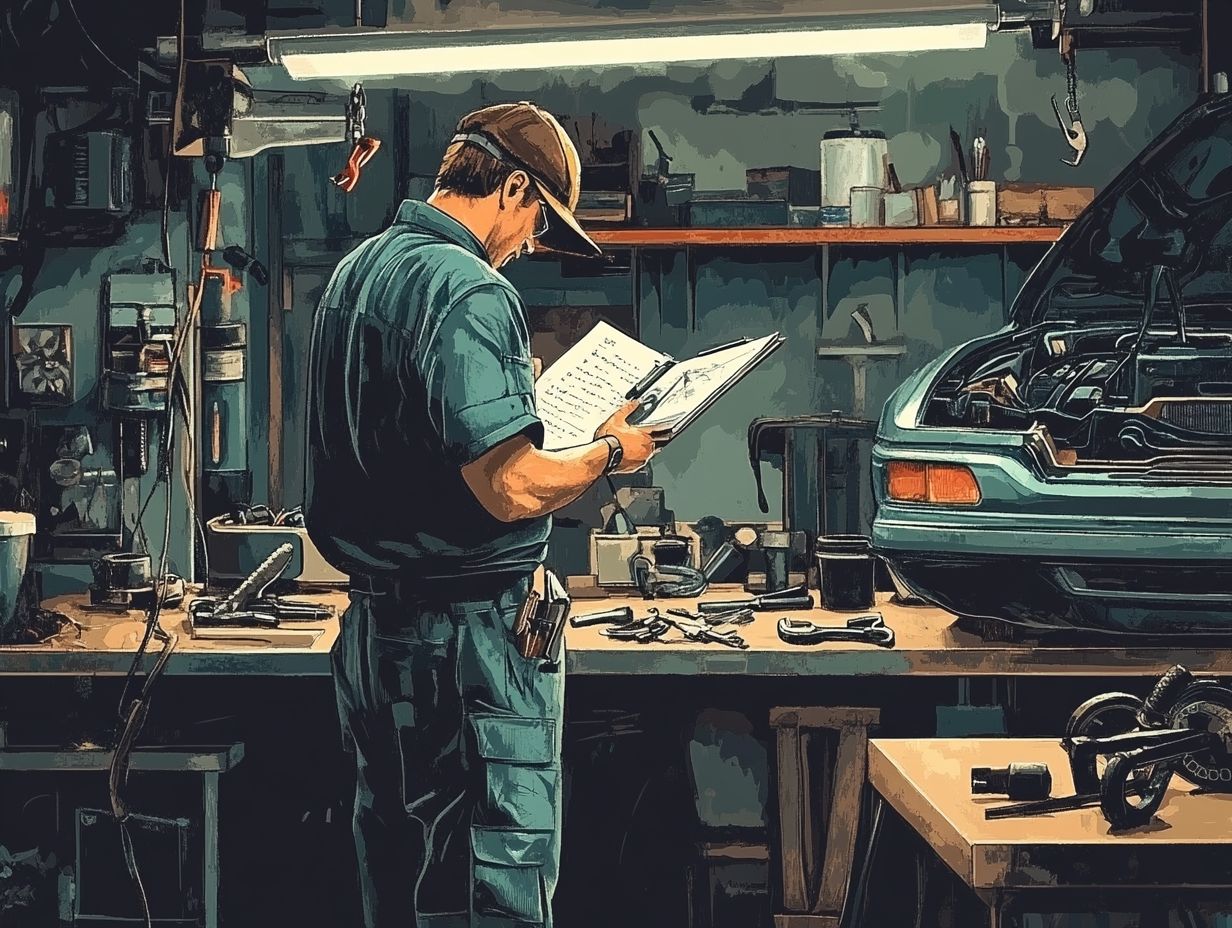
A ‘diagnostic code’ is a code that helps identify problems with your car. It is generated by the vehicle’s on-board computer to pinpoint issues in the vehicle’s systems. Mechanics use these codes to troubleshoot and determine the necessary repairs.
What is the difference between ‘preventive maintenance’ and ‘routine maintenance’ in understanding common car repair terminology?
‘Preventive maintenance’ refers to regular tasks performed on a vehicle to prevent potential problems or breakdowns. In contrast, ‘routine maintenance’ refers to scheduled tasks that are recommended by the vehicle manufacturer.
What does ‘OEM’ stand for in understanding common car repair terminology?
‘OEM’ stands for ‘original equipment manufacturer’ and refers to parts made by the same company that produced the original parts for the vehicle. These parts are often of higher quality and are recommended by the vehicle manufacturer for repairs.
What does ‘aftermarket’ mean in understanding common car repair terminology?
‘Aftermarket’ refers to parts made by a company other than the original manufacturer of the vehicle. These parts may be less expensive than OEM parts but might not meet the same quality standards.
What does ‘labour rate’ refer to in understanding common car repair terminology?
‘Labour rate’ is the hourly rate charged by a mechanic or repair shop for their services. This rate can vary depending on the location and the type of service being performed.
What is meant by ‘warranty’ in understanding common car repair terminology?
A ‘warranty’ is a guarantee provided by the manufacturer or seller that covers the repair or replacement of certain parts or systems within a specified time period. It is important to understand the terms and length of a warranty when having a vehicle repaired.
Your vehicle’s safety depends on the right mechanic, so choose wisely! Start researching today to find the mechanic that’s right for you!


